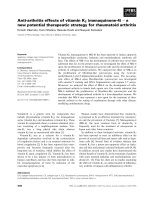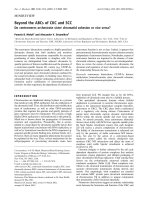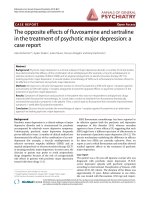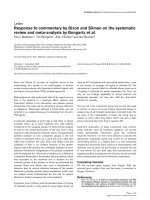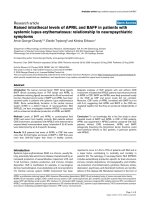Báo cáo y học: "Welcome to Journal of Foot and Ankle Research: a new open access journal for foot health professionals.c" ppt
Bạn đang xem bản rút gọn của tài liệu. Xem và tải ngay bản đầy đủ của tài liệu tại đây (554.76 KB, 6 trang )
BioMed Central
Page 1 of 6
(page number not for citation purposes)
Journal of Foot and Ankle Research
Open Access
Editorial
Welcome to Journal of Foot and Ankle Research: a new open access
journal for foot health professionals
Hylton B Menz*
1
, Mike J Potter
2
, Alan M Borthwick
2
and Karl B Landorf
1,3
Address:
1
Musculoskeletal Research Centre, Faculty of Health Sciences, La Trobe University, Bundoora, Victoria, Australia,
2
School of Health
Sciences, University of Southampton, Southampton, UK and
3
Department of Podiatry, Faculty of Health Sciences, La Trobe University, Bundoora,
Victoria, Australia
Email: Hylton B Menz* - ; Mike J Potter - ; Alan M Borthwick - ;
Karl B Landorf -
* Corresponding author
Abstract
Journal of Foot and Ankle Research (JFAR) is a new, open access, peer-reviewed online journal that
encompasses all aspects of policy, organisation, delivery and clinical practice related to the
assessment, diagnosis, prevention and management of foot and ankle disorders. JFAR will cover a
wide range of clinical subject areas, including diabetology, paediatrics, sports medicine, gerontology
and geriatrics, foot surgery, physical therapy, dermatology, wound management, radiology,
biomechanics and bioengineering, orthotics and prosthetics, as well the broad areas of
epidemiology, policy, organisation and delivery of services related to foot and ankle care. The
journal encourages submission from all health professionals who manage lower limb conditions,
including podiatrists, nurses, physical therapists and physiotherapists, orthopaedists, manual
therapists, medical specialists and general medical practitioners, as well as health service
researchers concerned with foot and ankle care. All manuscripts will undergo open peer review,
and all accepted manuscripts will be freely available on-line using the open access platform of
BioMed Central.
Background
Journal of Foot and Ankle Research (JFAR) is a new, open
access peer-reviewed online journal that encompasses all
aspects of policy, organisation, delivery and clinical prac-
tice related to the assessment, diagnosis, prevention and
management of foot and ankle disorders. JFAR is the offi-
cial research publication of the Society of Chiropodists
and Podiatrists (UK) and the Australasian Podiatry Coun-
cil. However, the Editorial Board encourages submission
from all health professionals who manage lower limb
conditions, including podiatrists, nurses, physical thera-
pists and physiotherapists, orthopaedists, manual thera-
pists, medical specialists and general medical
practitioners, as well as health service researchers con-
cerned with foot and ankle care.
JFAR builds upon a long and proud history of scholarly
publication in the podiatry profession. The first foot-
related journal in the UK, The Chiropodist, was published
by the National Society of Chiropodists in January 1914.
The National Society of Chiropodists was wound up in
1915, to be replaced with the Incorporated Society of Chi-
ropodists, which published its first journal as a continua-
tion of The Chiropodist. Following the amalgamation of
the Incorporated Society of Chiropodists with four other
bodies at the end of 1945, the newly formed Society of
Published: 28 July 2008
Journal of Foot and Ankle Research 2008, 1:1 doi:10.1186/1757-1146-1-1
Received: 12 May 2008
Accepted: 28 July 2008
This article is available from: />© 2008 Menz et al; licensee BioMed Central Ltd.
This is an Open Access article distributed under the terms of the Creative Commons Attribution License ( />),
which permits unrestricted use, distribution, and reproduction in any medium, provided the original work is properly cited.
Journal of Foot and Ankle Research 2008, 1:1 />Page 2 of 6
(page number not for citation purposes)
Chiropodists produced its first journal, still called The
Chiropodist, in January 1946. This incarnation of the jour-
nal was continuous up until January 1989, when it was
merged with the British Journal of Chiropody (originally the
journal of the British Association of Chiropodists, later
becoming an independent outlet after the Association
merged with the Society of Chiropodists in 1945). The
new journal was still called The Chiropodist, but with a new
sub-title: The Journal of British Podiatric Medicine, which
became the full title in 1991. The final manifestation of
the journal – the British Journal of Podiatry – represented a
merger between The Journal of British Podiatric Medicine
and the British Journal of Podiatric Medicine and Surgery,
which occurred in response to the amalgamation of the
Podiatry Association, the Association of Chief Chiropody
Officers and the Society of Chiropodists to form the Soci-
ety of Chiropodists and Podiatrists in 1998 [1]. Cover
images of the three main phases of the UK journal are
shown in Figure 1.
The chiropody/podiatry profession in Australia and New
Zealand was strongly influenced by the UK model, and
despite considerable delays in the dispatch processes of
the journal, it would appear that The Chiropodist did have
a small number of eager subscribers in "The Colonies"
(Figure 2). However, it was not until 1966 that the first
podiatry journal in Australia (the Australian Journal of Chi-
ropody) was published. This journal was renamed the Aus-
tralian Podiatrist in 1974. Most recently, following the
amalgamation of the Australian Podiatry Council and the
New Zealand Society of Podiatrists to form the Australa-
sian Podiatry Council in 1997, the Australian Podiatrist
merged with the New Zealand Journal of Podiatric Medicine
to form the Australasian Journal of Podiatric Medicine (see
Figure 3).
The late 1990s witnessed an ongoing debate regarding the
future of scholarly publishing in the Australasian and UK
podiatry professions which arose from two related issues:
the growing need for podiatry researchers to publish in
high profile journals, and the drive towards international-
isation [2-5]. During this period, it was clear that sustain-
ing the two 'local' journals as credible research
publications was becoming increasingly difficult [6], as
podiatry researchers were turning to more prestigious,
higher profile journals indexed by Medline [7,8]. Indeed,
a survey of podiatry academic staff in Australia revealed
that the British Journal of Podiatry and the Australasian Jour-
nal of Podiatric Medicine were considered to be the least
prestigious of all foot and ankle publications, and that
academic staff considered inclusion in Medline to be the
most important factor to consider when selecting a jour-
nal to publish in [7].
In 2005, tentative steps were taken to extend the degree of
collaboration between the two organisation's journals via
Chronology of chiropody/podiatry publications in the UKFigure 1
Chronology of chiropody/podiatry publications in the UK. A: The Chiropodist, B: the Journal of British Podiatric Medicine,
C: the British Journal of Podiatry.
Journal of Foot and Ankle Research 2008, 1:1 />Page 3 of 6
(page number not for citation purposes)
the reciprocal publication of selected papers (so-called
'international papers'). Finally, following several discus-
sions between 2005 and 2006, including a meeting held
during the 21
st
Australasian Podiatry Conference in
Christchurch (see Figure 4), the Australasian Podiatry
Council and Society of Chiropodists and Podiatrists
reached an agreement to develop a new journal. Subse-
quently, the final edition of the British Journal of Podiatry
(Vol. 10, No. 4) was published in November 2007 [9],
and the final edition of the Australasian Journal of Podiatric
Medicine (Vol. 41, No. 3) was published in December
2007 [10], paving the way for the development of the new
journal, Journal of Foot and Ankle Research (JFAR).
Why open access publishing?
The re-evaluation of scholarly publishing by the Australa-
sian Podiatry Council and Society of Chiropodists and
Podiatrists coincided with a major upheaval in biomedi-
cal publishing. Motivated by the growth of the internet
and a desire to enable wider access to scientific informa-
tion, the concept of open access publishing gathered con-
siderable momentum in the late 1990s [11-14]. Open
access publishing enables researchers to submit manu-
scripts to web-based journals that can be downloaded free
of charge by anyone with an internet connection, with no
subscription or registration barriers. The costs of publish-
ing are borne by the author, or, in most cases, by the
author's institution or funding body. In this way, access to
scholarly information is vastly increased, and the costs of
publishing research are contained. BioMed Central [15],
the publisher of JFAR, is the world's largest open access
publishing company, and currently produces 186 jour-
nals.
Letter to the editor of The Chiropodist (1924, Vol. 11, p 225) from a satisfied Australian subscriberFigure 2
Letter to the editor of The Chiropodist (1924, Vol. 11,
p 225) from a satisfied Australian subscriber.
Chronology of chiropody/podiatry publications in AustraliaFigure 3
Chronology of chiropody/podiatry publications in Australia. A: The Australian Journal of Chiropody, B: Australian Podiatrist,
C: the Australasian Journal of Podiatric Medicine.
Journal of Foot and Ankle Research 2008, 1:1 />Page 4 of 6
(page number not for citation purposes)
Open access publishing with Biomed Central offers sev-
eral significant benefits over the traditional publication
model [16], including:
(i) Rapid peer review: the peer review process in many
journals is often frustrating and time-consuming, and
may in some cases take over 12 months to complete. For
JFAR, this process is streamlined due to BioMed Central's
web-based system for submission and for referees to view
manuscripts and return their reviews.
(ii) High visibility and accessibility: publishing in JFAR
provides authors with access to a truly global readership
in medicine and allied health. PubMed [17], the world's
most popular literature search service, indexes all research
published in BioMed Central journals. It is worth noting
that the precursor journals to JFAR – the Australasian Jour-
nal of Podiatric Medicine and the British Journal of Podiatry
– were not indexed in PubMed, and several current foot
and ankle journals, such as Foot and Ankle Surgery and The
Foot are also not indexed in PubMed. BioMed Central also
participates in CrossRef [18] and the Open Citation
Project [19], allowing direct linking from citations to the
full text of the article in a BioMed Central journal.
(iii) Vastly reduced time period between acceptance of a
manuscript and its publication: for most journals, it can
take between six and 24 months from acceptance of a
paper to final availability in hard copy. This delay occurs
because of the need to produce paper issues on a monthly,
bimonthly or quarterly basis with a fixed number of
pages, which can create a substantial publishing backlog.
With JFAR, this unnecessary delay is removed, and articles
will be published on-line within a few days of editorial
acceptance.
(iv) The author retains copyright: with traditional jour-
nals, the author transfers ownership of their article to the
publisher, who can legally restrict access to the article
(even to the point of restricting sharing of the article
Breakfast meeting to discuss the new journal at the 21
st
Australasian Podiatry Conference, Christchurch, New Zealand, 3.9.2005Figure 4
Breakfast meeting to discuss the new journal at the 21
st
Australasian Podiatry Conference, Christchurch, New
Zealand, 3.9.2005. From left to right: Wayne Tucker, Stuart Baird, Mike Potter, Prof Keith Rome, John Price, Matthew Dil-
not, A/Prof Hylton Menz, Alison Petchell, Carol Mioduchowski, Richard Masoetsa, Matthew Slattery, Dr Karl Landorf, Dr Alan
Borthwick, Dr Anita Raspovic and Craig Payne.
Journal of Foot and Ankle Research 2008, 1:1 />Page 5 of 6
(page number not for citation purposes)
between colleagues). With open access journals, the
author retains copyright and grant any third party the
right to use the article freely, as long as its integrity is
maintained and its original authors, citation details and
publisher are identified.
(v) Web-based flexibility: traditional print journals are
forced to restrict the size of articles due to the cost of pro-
ducing printed issues. In some journals, articles are
restricted to 2,000 words or less, which creates difficulties
for authors and may require the deletion of potentially
important information. In addition, many journals
charge the author for reproduction of colour images. In
contrast, the web interface of BioMed Central journals
allows for larger articles, and the unrestricted inclusion of
non-written material such as high resolution colour pho-
tographs, additional datasets and movie files.
Articles published in open access journals are subject to an
article processing charge, which helps fund the journal
and enables free access to articles worldwide. If the sub-
mitting author of a manuscript belongs to an institution
that has a subscription to BioMed Central, the article
processing charge is waived. There are currently 319 Mem-
bers and Supporter Members in 34 countries [20].
Authors who do not belong to a BioMed Central member
institution pay an article processing charge upon publica-
tion. However, as part of the agreement formulated
between the Australasian Podiatry Council and the Soci-
ety of Chiropodists and Podiatrists, all Association/Soci-
ety members who wish to submit a manuscript will have
their article processing charge covered.
What is the role of JFAR?
Scholarly journals exist primarily as an avenue for the dis-
semination of research findings. For clinical journals, this
dissemination should ideally encompass both "researcher
to researcher" and "researcher to clinician" transfer of
information, in order to educate clinicians and ultimately
improve clinical outcomes for patients. However, it has
been argued that journals have several broader roles, such
as promoting and reforming the professions they serve
[21]. As JFAR is supported by the premier bodies of the
podiatry professions in Australasia and the UK, the jour-
nal will inevitably have a strong podiatry emphasis. How-
ever, the editors acknowledge that the management of
foot conditions encompasses a range of health care pro-
fessionals [22], and that the structure, education and
scope of practice of these professions varies considerably
between different countries. JFAR will therefore welcome
all manuscripts that advance our understanding of foot
disorders, irrespective of the professional background or
country of origin of the contributing authors. In doing so,
we hope to foster greater awareness and collaboration
between foot health professionals, and help break down
historical, national and political barriers impeding the
progress and advancement of foot and ankle care.
What will be published in JFAR and how will it be
reviewed?
JFAR will focus primarily on original research articles, but
will also publish editorials, methodology articles, letters
to the editor, study protocols and reviews. Case reports
will only be considered if they provide unique or impor-
tant additional insights into the causes or treatment of
foot and ankle disorders. In addition, case reports must be
evidence-based where good evidence is available [23].
Manuscripts submitted to JFAR will initially be reviewed
by the editors and subsequently by two external peer
reviewers. Reviewers will be asked to indicate whether the
manuscript is scientifically sound, relevant and also to
indicate the level of interest to foot health professionals.
JFAR operates a fully open peer review system, meaning
that the identity of the authors is known to the reviewers,
and vice versa. There is no evidence that such a system
produces better quality reviews or changes reviewers' rec-
ommendations compared to traditional "closed" peer
review [24]. However, open peer review is a far more
transparent system, potentially fosters greater accounta-
bility on the part of reviewers, and may also prevent
potentially serious abuses of the system (such as reviewers
stealing authors' ideas or intentionally slowing the
progress of a competitor's manuscript) [21]. All corre-
spondence pertaining to the peer review process, includ-
ing peer reviewers' comments, authors' replies and
revisions of the manuscript will be freely accessible from
the 'prepublication history' section of each article pub-
lished on the JFAR website.
Within a few days after acceptance in JFAR, provisional
versions of articles will be published on our website [25]
as Portable Document Files (PDFs). The provisional ver-
sion corresponds to the manuscript as it appeared upon
final acceptance by the editors, and the reference will
appear in PubMed as an 'Epub ahead of print'. Fully for-
matted PDF and full text (HTML) versions with cross-
linked reference lists are made available shortly after-
wards. This system allows the full text of research atricles
to be rapidly accessible to clinicians and researchers and
vastly reduces the turnaround time between submission
and publication. Final versions will be accessible and
searchable through the JFAR web archives, as well as
PubMed, Google Scholar, Scopus and several other schol-
arly databases. In addition to providing much wider dis-
semination of research articles (BioMed Central articles
have an average of 2,000 downloads in the first 12
months of publication [26]), this approach also benefits
authors, as open access papers have been shown to attract
more citations than non-open access articles [27].
Publish with BioMed Central and every
scientist can read your work free of charge
"BioMed Central will be the most significant development for
disseminating the results of biomedical research in our lifetime."
Sir Paul Nurse, Cancer Research UK
Your research papers will be:
available free of charge to the entire biomedical community
peer reviewed and published immediately upon acceptance
cited in PubMed and archived on PubMed Central
yours — you keep the copyright
Submit your manuscript here:
/>BioMedcentral
Journal of Foot and Ankle Research 2008, 1:1 />Page 6 of 6
(page number not for citation purposes)
Where to from here?
The editors of JFAR hope that the journal will be enter-
taining, educational, provocative and clinically useful to
all health care professionals involved in the management
of foot and ankle disorders. We look forward to receiving
your submissions, general feedback as to how the journal
is progressing and suggestions for how it can be improved.
Authors' contributions
All authors assisted with drafting the manuscript, and all
authors read and approved the final manuscript.
Acknowledgements
The editors would like to sincerely thank all colleagues who have assisted
with the development of JFAR, including John Price, Alison Petchell and
Graeme Ramsay (former Chief Executive Officers of the Australasian Podi-
atry Council), Ralph Graham (former Chairman of the Society of Chiropo-
dists and Podiatrists) and Dr Stefan Busch (Associate Publisher, BioMed
Central). We would also like to thank our current Board of Management,
including Joanna Brown (Chief Executive Officer, Society of Chiropodists
and Podiatrists), Kelli Cheales (Chief Executive Officer, Australasian Podia-
try Council), Clare Richards (Society of Chiropodists and Podiatrists) and
Anita Raspovic (Australasian Podiatry Council and former editor of AJPM).
References
1. Anonymous: The Camden Accord - the publications. J Brit Podi-
atr Med 1997, 52:169-170.
2. Anonymous: International journals. Brit J Podiatr 1999, 2:102.
3. Potter M, McCulloch A: Future plans for the British Journal of
Podiatry. Brit J Podiatr 2004, 6:91.
4. Potter M: Sustaining a high-quality professional journal . Brit J
Podiatr 2004, 7:63.
5. Raspovic A: Re-appraisal of the role of the Australian Journal
of Podiatric Medicine. Australas J Podiatr Med 2002, 36:34,54.
6. Menz HB: Local podiatry journals are unsustainable. Brit J Podi-
atr 2004, 7:116.
7. Menz HB: Publication patterns and perceptions of the Aus-
tralian podiatric medical faculty. J Am Podiatr Med Assoc 2001,
91:210-218.
8. Borthwick AM: 'Publish and be damned': disseminating con-
temporary podiatric research. Brit J Podiatr 2004, 7:91-92.
9. Borthwick AM, Richards C: Continuity in change: the evolving
journal. Brit J Podiatr 2007, 10:125-126.
10. Raspovic A: Editor's goodbye. Australas J Podiatr Med 2007,
41:38,56.
11. Delamothe T, Smith R: Moving beyond journals: the future
arrives with a crash. BMJ 1999, 318:1637-1639.
12. Smith R: Electronic publishing in science - the revolution is
just beginning. BMJ 2001, 322:627-629.
13. Delamothe T: Open access publishing takes off. BMJ
2004,
328:1-3.
14. Frankish H: Publishing wars. Lancet 2004, 364:1391-1392.
15. BioMed Central - the Open Access Publisher [http://
www.biomedcentral.com]
16. BioMedCentral: Why publish in BioMed Central? [http://
www.biomedcentral.com/info/about/faq?name=why].
17. PubMed [
]
18. crossref.org - DOIs for research content [ss
ref.org/]
19. OpCit - the Open Citation Project [ />]
20. BioMedCentral: Members. [ />].
21. Smith R: The Trouble with Medical Journals. London , The Royal
Society of Medicine Press; 2006.
22. Jones CL: Who treats feet? J Am Podiatr Med Assoc 1995,
85:293-294.
23. Godlee F: Applying research evidence to individual patients.
Evidence based case reports will help. BMJ 1998,
316:1621-1622.
24. vanRooyen S, Godlee F, Evans S, Black N, Smith R: Effect of open
peer review on quality of reviews and on reviewers' recom-
mendations: a randomised trial. BMJ 1999, 318:23-27.
25. Journal of Foot and Ankle Research [otan
kleres.com]
26. BioMed Central's author survey results [med
central.com/info/authors/authorsubmit]
27. Eysenbach G: Citation advantage of open access articles. PLoS
Biol 2006, 4:e157.

